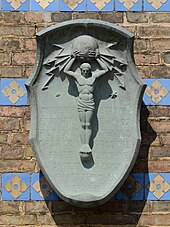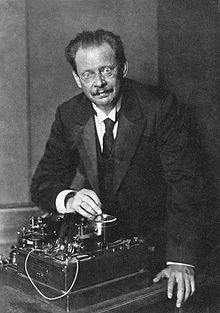Adolf Slaby
Adolf Karl Heinrich Slaby (born April 18, 1849 in Berlin , † April 6, 1913 in Charlottenburg ) was a German electrical engineer.
Slaby became the first professor of electrical engineering at the Royal Technical University of Charlottenburg in 1886 . Eleven years later, inspired by the work of Guglielmo Marconi in the field of radio telegraphy , he worked on the development of new techniques for wireless communication, which he improved and made popular. Through his personal access to Kaiser Wilhelm II , he did a lot for the social reputation of engineers and technology. His son was the engineer and designer Rudolf Slaby (1887–1953), co-founder of the Slaby-Beringer -Automobilwerke in Berlin.
Beginnings
Adolf Slaby was the son of a bookbinder and already showed an interest in mathematics and technology in secondary school. He enrolled at the Berlin Trade Academy, the forerunner of the Technische Hochschule Charlottenburg, to study mechanical engineering and mathematics , among others with Franz Reuleaux . In addition, he worked as a private tutor for the machine manufacturer Louis Schwartzkopff , which also resulted in intensive contact with practical mechanical engineering. In the absence of a doctorate at the commercial academies or schools at the time, Slaby completed his studies at the University of Jena , where he completed a mathematical thesis to become a Dr. phil. received his doctorate.
First teaching position
He then took up a teaching position in mathematics and mechanics at the Potsdam trade school, where he also experimented with hot air and gas machines. He wrote a theory of the gas engine, which is an important place in the development of the gasoline engine takes.
Electrical engineering

At that time, Berlin was the center of electrical engineering, in which Werner Siemens and his company played a major role. He personally supported Slaby in private studies in this field. Slaby was able to complete his habilitation at the Berlin Trade Academy in 1876 and then give lectures on electrical power machines, "electrical telegraphy " and electromechanics . In 1883 he became the first full professor of electrical engineering at the industrial academy, which has since been renamed the Königlich Technische Hochschule Charlottenburg, and his perfectly presented events met with great interest. Slaby found that theoretical lectures should be combined with internships, which enabled him to receive generous support from industry. In 1884 he and a colleague founded an electrotechnical laboratory , where he took over the " electrical machines " division and finally headed the facility as a professor of honor, while Hermann Wilhelm Vogel headed the " electrical lighting " department . So Berlin became the most important training center for the still young electrical engineering. In 1895 Slaby was elected a member of the Leopoldina .
Internal combustion engines
In addition to his work in the field of electrical engineering, Slaby also continued to research internal combustion engines. When the Electrotechnical Laboratory was founded, the same was also set up with test bench equipment for combustion engines at his request. Through systematic theoretical and experimental investigations, he also made an important contribution to the further development of the still young internal combustion engine and the development of internal combustion engine research as a scientific discipline. When using his caloric investigations in university teaching, he advocated the dissemination of thermodynamic exercises and testing facilities.
Radio links
Through personal acquaintance with the head of the English telegraph administration William Henry Preece in 1897 Slaby took part in Marconi's experiments with wireless telegraphy on the English Bristol Channel . He immediately recognized the importance of this invention, whereupon he immediately repeated and extended the experiments in Berlin and examined the physical and technical basics more closely. The emperor and the military authorities were also very interested in this. The wireless telegraphy attempts took place first at the TH Berlin and then between the Heilandskirche at the Port of Sacrow and the sailor station Kongsnæs at the Neuer Garten in Potsdam, 1.6 kilometers away . On October 7, 1897, a radio link was established from Schöneberg to Rangsdorf , which was already a world record with 21 kilometers, and in the following summer over 60 kilometers from Berlin to Jüterbog . Decisive improvements led to success: the spark gap was not in the transmitting antenna (as Marconi propagated), but in a circle inductively coupled with the antenna circuit.
Telefunken founded
The development of wireless communication technology, radio telegraphy , was also researched elsewhere, with a large company always behind it: at Slaby it was AEG, at Marconi it was Wireless Telegraph Co. and at Ferdinand Braun it was Siemens & Halske (p & H). This led to the fact that the radio message from a Slaby station was rejected by a Marconi station on the basis of their concession agreement. This untenable situation called for agreements: In 1903, S & H and AEG founded the Gesellschaft für wireless Telegraphie mbH, System Telefunken, as a joint venture in equal parts . Slaby's former assistant Georg Graf von Arco took over the management .
Commitment to the university
After he was both chairman of the Association of German Engineers (VDI) and in 1893 as a founding member first chairman of the Association of Electrical, Electronics and Information Technology (VDE) , he received personal access to Kaiser Wilhelm II. He gave lectures on technology in the Berlin Palace, however He also organized experimental lectures at the TH Berlin for the Kaiser. There, on the initiative of Alois Riedler, he campaigned for the social recognition of engineers and the complete equality of technical colleges with universities. The latter meant in particular the right to award doctorates for the technical universities, which they then received from Kaiser Wilhelm II in 1899. From 1894 to 1895 he was rector of the TH Berlin. In 1898, Adolf Slaby was the first representative of a TH to become a member of the Prussian manor for life .
Slaby was also from March 1, 1906 to January 18, 1912 chairman of the board of the Academic Association HÜTTE and member of the literary society " Tunnel over the Spree ".
Retirement
From 1906 Slaby held a special lecture on spark telegraphy until he finally retired in 1912 . His successor was Ernst Orlich , a representative of the classical mathematical treatment of the problems of theoretical electrical engineering.
Private life
Adolf Slaby was married to Julie Beringer (born April 6, 1857, died August 16, 1922). She was the daughter of the Berlin entrepreneur August Beringer . Both were buried in the family grave site on Luisenfriedhof II in Berlin-Charlottenburg.
memories

- In 1902 he was awarded the Grashof Memorial Medal by the Association of German Engineers .
- The family grave with the tombstones of Slabys and his wife Julie on Luisenfriedhof II has been preserved.
- A memorial plaque created by Hermann Hosaeus in 1928 above the entrance door of the Campanile in Sacrow indicates the radio test carried out there. In the center of the board, which is made of green dolomite , is Atlas with the globe, surrounded by lightning and the memorandum: At this site, Prof. Adolf Slaby and Count von Arco built the first German antenna system for wireless traffic in 1897.
- A “ Berlin memorial plaque ” is located on the grounds of the Technical University, Straße des 17. Juni 135, Charlottenburg-Wilmersdorf, on the northeast corner of the low-rise building of the Institute of Architecture (transport connection U 2 to Ernst-Reuter-Platz).
- In memory of Slaby, a stamp was issued by the Deutsche Bundespost Berlin (first day of issue on his 125th birthday on April 14, 1974).
- In two Berlin districts ( Treptow-Köpenick and Marzahn-Hellersdorf ) and in Cologne streets are named after Adolf Slaby.
- In Cologne the subway lines 13 and 18 stop at the “Slabystraße” stop.
literature
- Wolfgang Mathis: Slaby, Adolf Carl Heinrich. In: New German Biography (NDB). Volume 24, Duncker & Humblot, Berlin 2010, ISBN 978-3-428-11205-0 , p. 494 f. ( Digitized version ).
- Sieghard Scheffczyk: Adolf Slaby - pioneer of radio technology . In: CQ DL DAS AMATEURFUNKMAGAZIN, 4-2013, p. 271.
Web links
- Literature by and about Adolf Slaby in the catalog of the German National Library
- Biography in the commemorative publication 125 years of the Technical University of Berlin
- P. Noll: Historical personalities in communications engineering at the TH / TU Berlin
- “The New Telegraphy” by Adolf Slaby appeared in “The Century Magazine”, April 1898
- Information on the website of the Academic Association HÜTTE eV
Individual evidence
- ^ Adolf Sander: Prof. Dr. phil. Dr.-Ing. Adolf Slaby. av-huette.de, 2000, accessed on March 5, 2014 .
- ↑ Chronicle of the Kgl. TH 1799-1899, pp. 190ff
- ^ Adolf Karl Heinrich Slaby: Calorimetric studies on the cycle of the gas machine , 1891, p. VI
- ↑ Gustave Chauveau, Albrecht von Ihering: The gas machines: Theory and construction of engines operated with coal gas, generator gas, petroleum and gasoline vapors , 1895, p. 352
- ↑ Fassbender, ntz 1965
| personal data | |
|---|---|
| SURNAME | Slaby, Adolf |
| ALTERNATIVE NAMES | Slaby, Adolf Karl Heinrich (full name) |
| BRIEF DESCRIPTION | German electrical engineer |
| DATE OF BIRTH | April 18, 1849 |
| PLACE OF BIRTH | Berlin |
| DATE OF DEATH | April 6, 1913 |
| Place of death | Charlottenburg |


